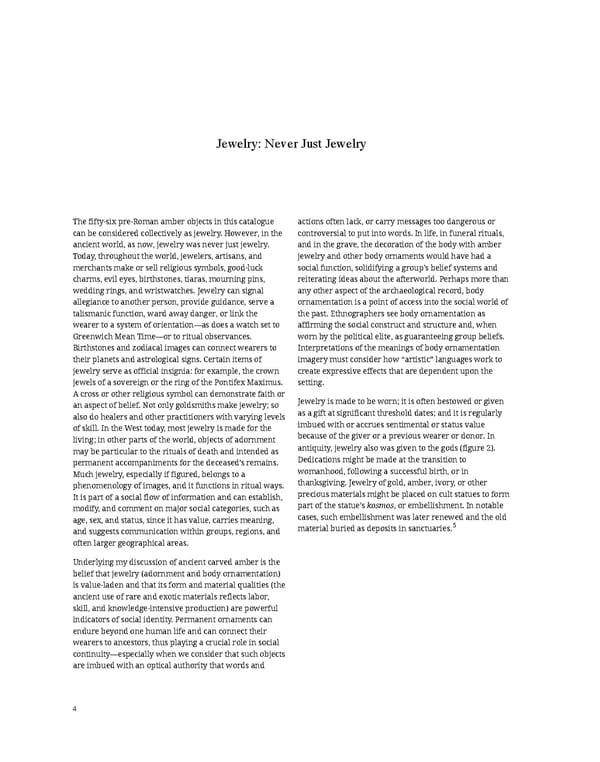Jewelry: Never Just Jewelry The fifty-six pre-Roman amber objects in this catalogue actions often lack, or carry messages too dangerous or can be considered collectively as jewelry. However, in the controversial to put into words. In life, in funeral rituals, ancient world, as now, jewelry was never just jewelry. and in the grave, the decoration of the body with amber Today, throughout the world, jewelers, artisans, and jewelry and other body ornaments would have had a merchants make or sell religious symbols, good-luck social function, solidifying a group’s belief systems and charms, evil eyes, birthstones, tiaras, mourning pins, reiterating ideas about the afterworld. Perhaps more than wedding rings, and wristwatches. Jewelry can signal any other aspect of the archaeological record, body allegiance to another person, provide guidance, serve a ornamentation is a point of access into the social world of talismanic function, ward away danger, or link the the past. Ethnographers see body ornamentation as wearer to a system of orientation—as does a watch set to affirming the social construct and structure and, when Greenwich Mean Time—or to ritual observances. worn by the political elite, as guaranteeing group beliefs. Birthstones and zodiacal images can connect wearers to Interpretations of the meanings of body ornamentation their planets and astrological signs. Certain items of imagery must consider how “artistic” languages work to jewelry serve as official insignia: for example, the crown create expressive effects that are dependent upon the jewels of a sovereign or the ring of the Pontifex Maximus. setting. A cross or other religious symbol can demonstrate faith or an aspect of belief. Not only goldsmiths make jewelry; so Jewelry is made to be worn; it is often bestowed or given also do healers and other practitioners with varying levels as a gift at significant threshold dates; and it is regularly of skill. In the West today, most jewelry is made for the imbued with or accrues sentimental or status value living; in other parts of the world, objects of adornment because of the giver or a previous wearer or donor. In may be particular to the rituals of death and intended as antiquity, jewelry also was given to the gods (figure 2). permanent accompaniments for the deceased’s remains. Dedications might be made at the transition to Much jewelry, especially if figured, belongs to a womanhood, following a successful birth, or in phenomenology of images, and it functions in ritual ways. thanksgiving. Jewelry of gold, amber, ivory, or other It is part of a social flow of information and can establish, precious materials might be placed on cult statues to form modify, and comment on major social categories, such as part of the statue’s kosmos, or embellishment. In notable age, sex, and status, since it has value, carries meaning, cases, such embellishment was later renewed and the old and suggests communication within groups, regions, and material buried as deposits in sanctuaries.5 often larger geographical areas. Underlying my discussion of ancient carved amber is the belief that jewelry (adornment and body ornamentation) is value-laden and that its form and material qualities (the ancient use of rare and exotic materials reflects labor, skill, and knowledge-intensive production) are powerful indicators of social identity. Permanent ornaments can endure beyond one human life and can connect their wearers to ancestors, thus playing a crucial role in social continuity—especially when we consider that such objects are imbued with an optical authority that words and 4
 Ancient Carved Ambers in the J. Paul Getty Museum Page 13 Page 15
Ancient Carved Ambers in the J. Paul Getty Museum Page 13 Page 15